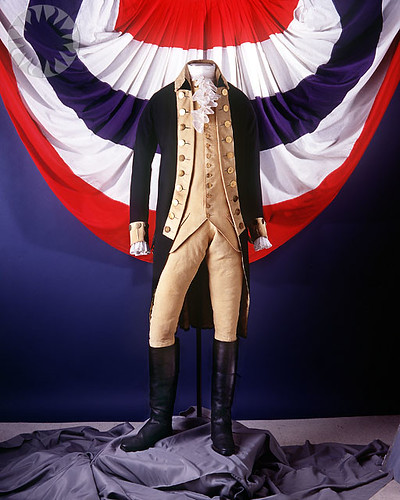 As Caroline Weber theorizes in her amazing book, Queen of Fashion, the vogue du jour contained greater meaning and had a greater effect in the 18th century than it does today. Weber goes as far to hypothesize that it was Marie Antoinette's wardrobe that had a monumental effect in her fall from grace and gives great evidence to support her theory. On the other side of the channel, Georgiana was just as much of a fashion icon and her influences had similar effects in society. Fashion played a significant part in politics as well. In a time where television was not there to force politics into the faces of the countrymen, fashion, and more specifically color.
As Caroline Weber theorizes in her amazing book, Queen of Fashion, the vogue du jour contained greater meaning and had a greater effect in the 18th century than it does today. Weber goes as far to hypothesize that it was Marie Antoinette's wardrobe that had a monumental effect in her fall from grace and gives great evidence to support her theory. On the other side of the channel, Georgiana was just as much of a fashion icon and her influences had similar effects in society. Fashion played a significant part in politics as well. In a time where television was not there to force politics into the faces of the countrymen, fashion, and more specifically color.So what palette was was appropriate for your wardrobe?

If you were a supporter of the Whig party, you could show your support in ensembles of blue and buff. These colors graced the uniforms of the American revolutionaries and were adopted by the Whigs who commiserated to the colonists' plight under King George.
 If your sentiments tended to favor the Tory party, then another fashionable color option was laid before you. Green was their color of choice and was publicized in portraits of loyal Tories such as Banstre Tarleton.
If your sentiments tended to favor the Tory party, then another fashionable color option was laid before you. Green was their color of choice and was publicized in portraits of loyal Tories such as Banstre Tarleton.

*Shakes fist at Banstre Tarleton* Gah, what a rotten excuse for a man! Sorry, he's just one of those historical figures I'd really love to give the what-for. I was going to answer his personal ad from a few weeks back, but I couldn't come up with a suitable reply that didn't sound so shrewish that he would suspect it was Mrs. Robinson writing under yet another assumed name :p
ReplyDeleteBut to the topic at hand -- couture! I am especially fascinated by the role of fashion in 18th century politics. Not only what people wore, but the behind-the-scenes aspects of where that clothing came from. Marie Antoinette switches from satin to muslin and the French silk industry collapses. The muslin is imported from England, woven in English mills from cotton imported from the American colonies. The American cotton is grown and harvested by slave labor, a system so lucrative that the debate over it's abolition nearly prevents the signing of the Declaration of Independence; said debate is not resolved for another 75-odd years.
So, in conclusion: Marie Antoinette's desire for chemise gowns is responsible for the American Civil War. Yes/no?
Don't mind me, I read too much. I could go on like this for days.....
Oh, and for the record, I vote Whig! (Woo! Go Fox!)
I love how, in previous centuries, fashion was interwoven with politics. Now days, it's a fine line to walk. Should the wife of a political candidate be too interested in fashion, she comes off as an airhead...and yet, if it's all business all the time, she's portrayed as a bitch.
ReplyDeleteLoving your blog, as always!
First of all, Haha at Tarleton.
ReplyDeleteSecondly, I like where you're going with this...and yes I am avoiding going on a tangent about it in a comment, lol.
And thanks Kira! Contemp Politics and fashion is something I've been thinking about a lot lately especially since I was reading Queen of Fashion while Hillary was campaigning. Once again, something that makes my head explode once I start thinking/talking about it.